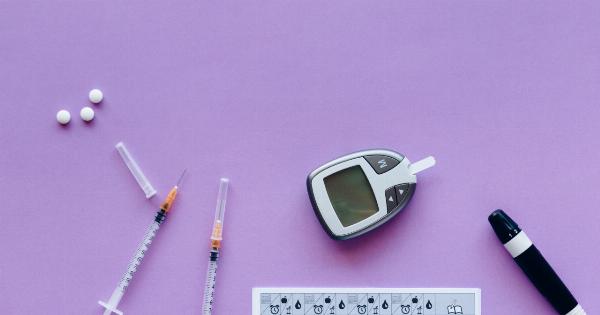Diabetes is a chronic disease that affects millions of people worldwide. It is characterized by high blood sugar levels resulting from the body’s inability to produce or use insulin effectively.
While there are several treatment options available for diabetes, researchers are constantly exploring new approaches to improve the management and ultimately find a cure for this condition. One avenue of investigation involves the potential use of precious metals in diabetes treatment.
Understanding Diabetes
Before delving into the potential role of precious metals, it is important to have a comprehensive understanding of diabetes. There are two main types of diabetes:.
Type 1 Diabetes
Type 1 diabetes, also known as juvenile diabetes or insulin-dependent diabetes, occurs when the body’s immune system mistakenly attacks the cells in the pancreas responsible for producing insulin.
Insulin is a hormone that regulates blood sugar levels, and without it, the body cannot efficiently control glucose metabolism. Type 1 diabetes typically develops in childhood or adolescence and requires lifelong insulin injections for management.
Type 2 Diabetes
Type 2 diabetes is the most common form of diabetes, accounting for roughly 90% of all cases. Unlike type 1 diabetes, type 2 diabetes is often associated with lifestyle factors such as obesity, sedentary behavior, and poor dietary choices.
In this condition, the body becomes resistant to the effects of insulin, leading to elevated blood sugar levels. Type 2 diabetes can usually be managed through lifestyle modifications, oral medications, or insulin therapy.
The Growing Burden of Diabetes
Diabetes is a significant global health concern, with its prevalence on the rise.
According to the International Diabetes Federation (IDF), approximately 463 million adults were living with diabetes in 2019, and this number is projected to reach 700 million by 2045. Furthermore, the disease is responsible for more than 4.2 million deaths per year and accounts for a considerable economic burden on both individuals and healthcare systems.
The Need for Innovative Diabetes Treatments
Given the alarming rise in diabetes cases, there is an urgent need for innovative treatments that can effectively manage the disease and reduce its complications.
Traditional treatments, such as insulin injections and oral medications, have limitations and can be associated with side effects. This has led researchers to explore alternative approaches, including the use of precious metals.
Gold in Diabetes Management
Gold nanoparticles have gained significant attention in recent years for their potential applications in various fields, including medicine.
In the context of diabetes, gold nanoparticles show promise in two key areas: glucose sensing and drug delivery.
Glucose Sensing
Accurate and continuous monitoring of blood glucose levels is crucial for effective diabetes management. Gold nanoparticles can be utilized in the development of glucose sensors that provide real-time and non-invasive monitoring.
These nanosensors can detect glucose levels in bodily fluids such as tears or saliva, eliminating the need for frequent finger pricks. Gold nanoparticles possess unique optical properties that enable the detection of glucose through changes in color or fluorescence intensity.
Drug Delivery
Another exciting application of gold nanoparticles in diabetes treatment is their potential as drug delivery vehicles. Conventional diabetes medications often face challenges related to solubility and stability, as well as the need for frequent dosing.
Gold nanoparticles can be functionalized with insulin or other anti-diabetic drugs and used to deliver these compounds directly to the target cells or tissues. The controlled and targeted release of medications may improve treatment efficacy while minimizing side effects.
Silver as an Antimicrobial Agent
Bacterial infections are a common complication of diabetes, particularly in individuals with poorly controlled blood sugar levels.
Silver has long been known for its antimicrobial properties, and its potential role in managing diabetes-related infections is being explored.
Silver-Based Dressings
Chronic wounds, such as diabetic foot ulcers, pose a significant challenge in diabetes management. In addition to glucose control, wound care plays a critical role in preventing complications.
Silver-based dressings, which incorporate silver nanoparticles or ions, have shown efficacy in preventing infection and promoting wound healing. These dressings can help combat antibiotic-resistant bacteria, a prevalent concern in diabetic foot ulcers.
Platinum and Ruthenium in Islet Cell Transplantation
Islet cell transplantation is a promising approach for individuals with type 1 diabetes, offering the potential for long-term insulin independence.
However, the survival and function of transplanted islet cells are hampered by immune rejection and oxidative stress. Precious metals such as platinum and ruthenium may hold the key to addressing these challenges.
Platinum-Based Nanoparticles
Platinum-based nanoparticles can serve as protective agents for transplanted islet cells. These nanoparticles scavenge harmful reactive oxygen species, protecting the cells from oxidative stress-induced damage.
In addition, platinum-based nanoparticles can enhance the immunosuppressive effects of existing medications, reducing the risk of rejection and prolonging graft survival.
Ruthenium Complexes
Ruthenium complexes have shown promise in improving the viability and function of transplanted islet cells.
These complexes possess unique antioxidant properties and can stabilize cell membranes, preserving the functionality of islet cells post-transplantation. Furthermore, ruthenium complexes can modulate the immune response, reducing the risk of rejection and the need for high doses of immunosuppressive drugs.
Conclusion
The use of precious metals in diabetes treatment represents an exciting avenue of research. Gold nanoparticles hold potential in glucose sensing and drug delivery, revolutionizing how individuals monitor and manage their blood sugar levels.
Silver-based dressings offer a novel approach to combatting infections in chronic wounds, which are prevalent in diabetes. Platinum and ruthenium show promise in enhancing the success of islet cell transplantation, offering hope for long-term insulin independence in individuals with type 1 diabetes.
While more research and clinical trials are needed, precious metals hold the potential to change the future of diabetes treatment.



























